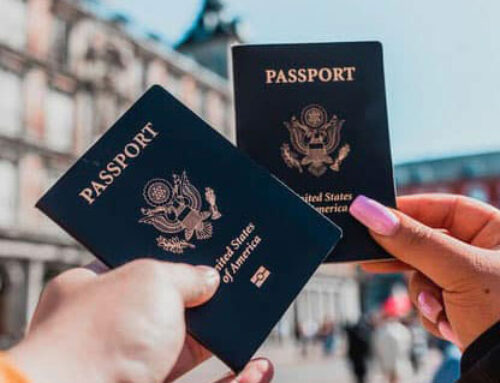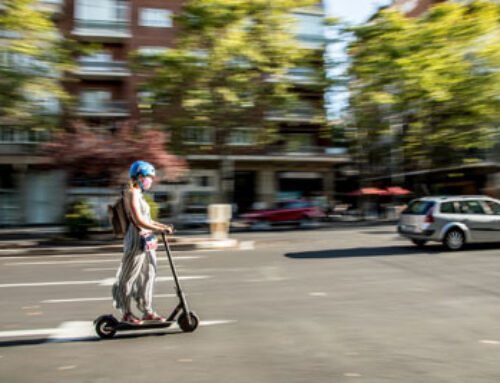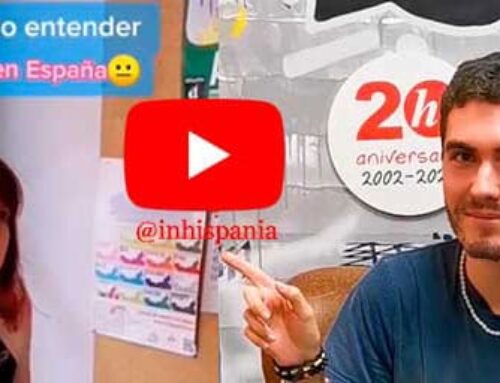📍 Inhispania is a Spanish language school for foreigners in the centre of Madrid. The exact address is 3 Marqués de Valdeiglesias Street. It is a small street perpendicular to Gran Vía, 5 minutes walk from Cibeles Square. You can get there in just a few minutes from anywhere in Madrid. As the school is in the centre of Madrid, after class there are lots of different activities to do and to please all tastes! Below we explain you many cool things to do near Inhispania. 😮
+
1. Visit the city’s main museums
In 2021 UNESCO included the Paseo del Prado between Cibeles and the Emperor Charles V Square (Atocha), the Buen Retiro Park and the Jerónimos neighbourhood as a World Heritage Area. This area called “Paisaje de la Luz” is a privileged place where culture, science and nature come together. We are very lucky to have the school right there! Inhispania is a 10-minute walk from the Prado Museum, the Reina Sofia Museum and the Thyssen-Bornemisza.
If you are an art lover, you will love visiting these museums because they cover an endless variety of styles and artists, both Spanish and foreign.
– Prado Museum
First of all, the Prado Museum in Madrid. This collossal museum first opened its doors to the public in 1819 containing 311 paintings. Nowadays in the museum there are more than 7,500 works: engravings, paintings and sculptures. Even the building itself is a magnificent display of neoclassical splendour! In this museum you can admire internationally famous works such as “La Maja Desnuda” by Francisco de Goya, “The Cardinal” by Raphael, “The Venus” by Tiziano or “The Three Graces” by Rubens.
💡 Tip: Access to the museum is free from Monday to Saturday from 6pm to 8pm, and on Sundays and public holidays from 5pm to 7pm. Try to get there well in advance, as there is usually a long queue.
– Thyssen Bornemisza Museum
The Thyssen-Bornemisza Museum displays one of the richest and most varied private art collections. Due to the large number of artists of all origins, some critics have considered it as a synthesis of Western painting. There are art pieces of most European and North American art styles between the 14th and 20th centuries. Inside you can find works by Van Eyck, Caravaggio, Monet, Degas, Van Gogh and Kandinsky.
👉 Admission is free on Mondays and for people with a youth card or youth transport pass. There is a reduced fare (9 euros) for students and teachers.
– Reina Sofía Museum
The Reina Sofía Museum is one of the most important modern and contemporary art museums in Spain and Europe. The museum’s permanent collection includes Spanish artists of the 20th century (e.g. Pablo Picasso, Salvador Dalí and Joan Miró) as well as the work of some Surrealist, Cubist and New Figuration artists (e.g. Francis Bacon). Free opening hours: Monday, Wednesday, Thursday, Friday and Saturday from 7pm to 9pm, and Sunday from 12.30am to 2.30pm.
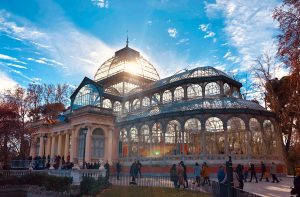
2. Go Shopping
After your Spanish language classes, you can also go shopping in the neighbourhood. The school is next to several large shopping areas such as Fuencarral Street, Chueca or Gran Via itself. These streets sell all kinds of products: clothes, shoes, jewellery, accessories and home decor. If you’ve forgotten to bring something on your trip, don’t worry, because you’ll find everything you need within a 10-minute walk.
For example, on Gran Vía street, almost reaching Callao square, there is a 5-storey building where they sell clothes, accessories, beauty products, decoration… In this shop, Primark, they sell everything you can imagine in a single building. Primark is gigantic, just like the Lefties clothing shop on Fuencarral street, which is currently the biggest shop of this brand in the world (4,000 square metres distributed over three floors).
In addition, a futuristic-looking shopping mall called Wow Concept has recently opened in this area. In this mall you can find almost any luxury brand, from clothing to technology to art.
3. Unwind at the Retiro Park
The Retiro Park or Parque del Buen Retiro is one of the most important and representative parks in Spain. This park was built in the first half of the 17th century as a garden belonging to the royal palace of the Spanish king at that time, Felipe IV. However, in 1868 it became state property and since then all Madrilenians and tourists can enjoy it free of charge and at any time of the day. Many people go to the Retiro Park to practice sports, to go for a walk or just to have a picnic lunch with their friends.
Within the Retiro Park we recommend you to visit 5 places:
- La Rosaleda: a garden full of flowers and fountains that is truly beautiful in spring.
- El Estanque del Retiro, an artificial lake where you can take a boat for 45 minutes for only 6 euros (on Saturdays, Sundays and public holidays it is a bit more expensive).
- El Ángel caído: a monument placed 666 metres above sea level, depicting an angel who has been expelled from Heaven.
- The viewpoint inside the Alfonso XII Monument: It is a viewpoint overlooking the pond, with a panoramic view of the park.
- El Palacio de Cristal: an art exhibition space belonging to the Reina Sofía Museum. It is an all-glass building in front of a small and nice lake.
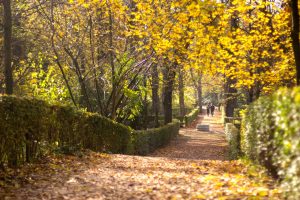
4. Try the best food
In the surrounding of Inhispania there is a wide variety of restaurants, bars and cafés of all kinds.
If you’re looking for a café, there’s a very trendy one in the Chueca neighbourhood called La Desayunería. Its speciality is pancakes, and it’s just a 5-minute walk from Inhispania. La Duquesita, arriving at the Alonso Martínez metro station, is a traditional pastry shop where they have been selling bonbons and cakes since 1914 (the decoration is gorgeous!). Celicioso is a bakery/café where they sell cakes and sweets for coeliacs. At Sweet Brothers you will find vegan desserts. Finally, in Puerta del Sol, 15 minutes away, you can have dessert in one of Madrid’s most famous and historic bakeries: La Mayorquina.
On the other hand, if you are looking for a place to have lunch or dinner, in the gastronomic market of San Antón you can try dishes from different countries without leaving Madrid: from Italian pasta and Spanish omelettes to American hamburgers and Peruvian ceviches. Next to Sol square, there is an Asian street market with a multitude of dishes from different Asian countries (Indian, Japanese, Vietnamese and Korean cuisine). We highly recommend you visit this market.
If you are vegan or vegetarian, the Honest Greens restaurant will be your best option. Moreover, on the top floor of the El Corte Inglés building in Callao you’ll find a gastro area with pintxos, tapas, burgers and even ice cream. This restaurant area has spectacular views, overlooking Gran Vía, Callao and the emblematic Schweppes Building! Simply amazing.
Finally, if you are on a shoestring budget, just 2 minutes away from the school you will find a bar called El Tigre where they serve delicious tapas for very little money. 😉
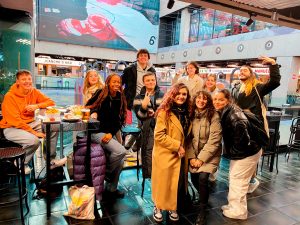
5. Enjoy the beautiful sunsets in Madrid
Madrid is famous for having the best sunsets and we recommend that you do not miss them if you are visiting the city. Around the school there are many rooftop restaurants and bars to enjoy them. Indeed, this is a great option specially for summer, as some of them have a swimming pool! 🔥
The best-known rooftops near the school are:
- Picalagartos, which is not very expensive and it’s next to the Gran Vía metro.
- The Oscar Room Mate Hotel, with a swimming pool, in the Chueca neighbourhood.
- The RIU Plaza España Hotel, where part of the Netflix series “Élite” was filmed. You can see the ground at 117 metres from a glass walkway!
- Finally, the rooftop of the Four Seasons Hotel, next to Puerta del Sol, where you can also try dishes from one of Spain's best chefs, Dani Brasserie, with 3 Michelin stars.
In Madrid, some rooftops are free while in others, you have to pay. Quite very often, when you eat on the terrace, the money you pay to access to the rooftop is discounted from the price of the drink or food you order, so it is not very expensive.
6. Discover Madrid city and learn about the Spanish history and culture
Every neighbourhood in Madrid has a peculiarity that makes it unique. Huertas is the neighbourhood where many famous old Spanish writers used to live. Malasaña is a neighbourhood where a cultural movement that arose a few years ago ended up leading to a great political transformation in the country. Lavapiés is a an example of peaceful coexistence among people from different cultures, religions and races. Chueca is the neighbourhood chosen by the LGTB community, etc. If you have never been to Madrid before or you are a foreigner living in Madrid, you might be interested in knowing more about Madrid's neighborhoods in this link.
We would advise you to go on a guided tour of the neighbourhood you like the most. There are some guided tours in which they explain you the literary Madrid, or specific stages of the Spanish History (of the Habsburgs or the Bourbons), others focus on cultural or social events such as the Movida madrileña, and you can even find tours about mysterious events that happened in the past.
At our Spanish language school Inhispania we usually organise tours for students to get to know the main monuments of the city, the most representative literary works of Spain and some of the buildings with an important role in the history of our country.
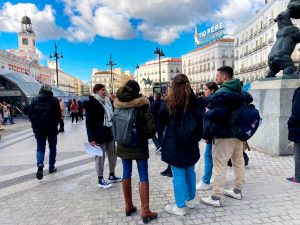
Tip: Sometimes on the Madrid City Council website there are some free guided tours offered. Get them in advance, they sell out quickly!
7. Enjoy watching a flamenco show
Another very interesting option to get to know the culture of Spain is to go to a flamenco show. There are several flamenco shows near the school, some of them very famous and long established.
- Tablao Flamenco Villa-Rosa
First of them, the Tablao Flamenco 1911 or Tablao Villa-Rosa. As the name suggests, this iconic flamenco tablao was founded in 1911. It is said to be the oldest tablao in the world. It is located in the Plaza de Santa Ana, in the Huertas neighbourhood, next to Puerta del Sol. It offers classical flamenco shows every day from 6 to 10 pm. The ticket price ranges from 19,50 to 49 euros, and you can buy it together with dinner for 16 euros more (prices per person).
- Cardamomo
Cardamomo is another tablao with a long history and one of the most appreciated by the public. It is located near the Sevilla metro station, very close to Puerta del Sol. It offers weekly shows with artists from all over Spain, even paying their travel and accommodation expenses. Their aim is to offer a huge variety in its programme. This tablao combines modernity with the purest essence of flamenco dance. As in the case of Villa Rosa, Cardamomo has 60-minute sessions and prices range from 19.50 to 49 euros, and a menu can be added for an extra 16 euros.
- Las Carboneras
Las Carboneras is a flamenco club located on the ground floor of the old Conde de Mirada Palace, in Madrid de los Austrias. The exact address is 1 Conde de Miranda Street, just 5 minutes from the Plaza Mayor. This place combines an avant-garde image and style with the best of modern flamenco. Periodically there are art exhibitions inside and they also offer high quality Spanish food. The price is 42 euros for a two-hour show (including drinks) or 65 euros for a tasting menu of tapas.
- Tablao Torero
In the Tablao Essential Flamenco or Tablao del Torero you can enjoy the best flamenco in a brick cave from more than a century ago. The acoustics are unbeatable. Furthermore, El Mistela, a dancer who won the National Flamenco Critics Award, directs the show. It lasts 1 hour and 15 minutes, and includes a brief introduction to the history of flamenco and one drink per person (beer, wine, sangria or soft drink). Tickets cost between 35 and 50 euros.
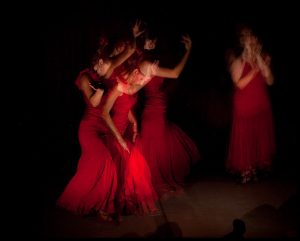
In addition to these, there are many other tablaos in Madrid that offer flamenco shows, some of which are very famous and highly recommended. For instance, the Corral de la Morería (near the Viaducto de Segovia) or the dinner show Olé Olá, which takes place in the emblematic Teatro Eslava. Sporadically and in a different format, Olé Olá also takes place in the Café Berlín, the Teatro Galileo Galilei or the Sala Clamores. This Olé Olá show is not like the traditional flamenco show, but recitals by singers and musicians who fuse flamenco with other musical styles such as jazz, pop or rock.
8. Buy the Real Madrid football team kit
Are you a fan of the Real Madrid football team, Barça or Atlético de Madrid? Near our school you can buy official shirts or shorts, just like the ones worn by the players of these teams in the matches.
The official Real Madrid shops are on 31 Gran Vía Street, Del Arenal Street and Del Carmen Street, next to Puerta del Sol Square. The official Atlético de Madrid shop is on 47 Gran Vía Street. Finally, the official Barça shop is on Del Arenal Street, number 9. Of course, you can also buy the official kit in other places such as the Bernabéu Stadium or the Wanda Metropolitano, although both are a bit further away from the school (and from the centre of Madrid).
9. Go out at night in Madrid
"Madrid never sleeps" is an expression that is usually used to mean that in Spain at night there are many different pubs and discos open until late hours. You can go to a pub have a good time with your friends, no matter what time you go. There are pubs that open really early, at 6pm for example, and others that open really late until almost midday. Unlike other European cities or other places in the world, in Madrid it is normal to go out late, so all the pubs open at that time (12-1pm).
In this post we give you some ideas of trendy places to go. Apart from those, we would like to add a pub that has recently opened with a wide variety of themes, now with an Indian aesthetic. They offer delicious cocktails and they sometimes organise language exchanges. You will love it! It's called Calle 360.
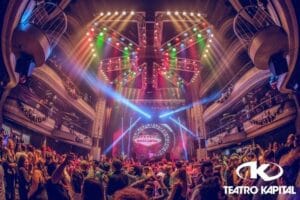
10. Get relaxed in a spa in Madrid centre
If you walk up Carretas Street from Puerta del Sol, you'll come to the Jacinto Benavente Square. Right there is a wellness centre. They offer massages and Arabic baths. Sounds incredible, doesn't it? Hammam’s aesthetics is inspired by Arab and Asian culture, and it is certainly a place that contrasts profoundly with its surroundings. It's a perfect place to have a relaxing soak in a spa after an afternoon of shopping, sightseeing in Madrid or an exam of Spanish language at school.
In the Hammam you can choose from a wide range of offers including a tour of warm, hot and cold thermal baths and a steam room. You can also choose between a relaxing massage with essential oils and a relaxing massage with natural foam on hot stone. Prices range from 37 euros to 90 euros, depending on the number of options you choose and the type of each one. For example, the Arabic bath costs 37 euros, and a relaxing massage with bath costs 49 euros.
We hope you liked all these plans as much as we did. You will no longer have any excuse not to go out with your friends after school - all these places are less than 20 minutes away from our school! 😊 If you can think of any other cool things that we can include, we will be really happy to hear about them at info@inhispania.com Have a great day and enjoy your stay in Madrid, there are many cool things to do here and many cool people to meet!






